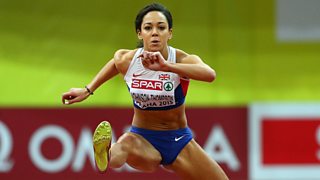Characterized by Continuous Long duration Sustained Activities
Keeping fit and healthy in sport
Health, fitness and exercise are essential to the sporting and life performance of humans. The relationship between the three is cyclical.
The components of fitness – definitions, examples and tests
Cardiovascular endurance/stamina
Definition: The ability of the heart, lungs and blood to transport oxygen during sustained exercise. Our heart and lungs are able to cope with activity for relatively long periods of time without getting tired.
Examples: Cardiovascular endurance is particularly important in distance running, triathlon, playing a whole football or netball match without tiring.
Test 1: Multistage fitness test
20 m shuttles are run in time with the pre-set beeps. Each minute, the time between the beeps gets shorter, so running speed has to increase. When the runner can no longer keep up with the beeps, they stop and their final level is recorded and compared with the published tables.
Test 2: Cooper 12 minute run
The total distance run or walk round a marked area in 12 minutes is recorded and compared with the published tables.
Muscular endurance
Definition: The ability to use voluntary (skeletal) muscles repeatedly without tiring.
Examples: A rower repeatedly pulling their oar against the water to propel the boat towards the line; a cyclist's leg muscles turning the pedals; in the gym, completing 40 sit-ups.
Test 1: National Coaching Foundation abdominal curl test
This test measures the muscular endurance of the abdominal muscles. As many correct abdominal curls (sit-ups) as possible are performed in 30 seconds. The score is recorded and compared with the published tables.
Test 2: Press-up test
This test measures the muscular endurance of the chest and shoulder muscles. As many press-ups as possible are performed in 30 seconds or one minute. The score is recorded and compared with previous scores or other scores on the internet.
Speed
Definition: The ability to move all or part of the body as quickly as possible.
Examples: Speed is important in sprinting, speed skating, sprint cycling and sports such as tennis when a player has to move forward quickly from the baseline to reach a drop shot close to the net.
Test: 30 m sprint test
Run as fast as possible for 30 m from a standing or rolling start. Time is recorded and compared with previous times or other times on the internet.
Strength
Definition: The ability of a muscle to apply force and overcome resistance or the amount of force a muscle can exert.
Examples: A weightlifter performing a clean and jerk; putting the shot; a boxer punching a right hook; a rugby player in a scrum, pushing against the opposition pack.
Test 1: Handgrip dynamometer
The handle is squeezed as hard as possible with one hand. This gives a reading for the strength of hand grip.
Test 2: 1 Rep max (repetition maximum)
This is the heaviest weight that can be lifted once. It can be attempted using free weights or multigym equipment and should be worked up to gradually, with rests between lifts.
Flexibility
Definition: The range of movement (ROM) at a joint. It is the ability to move the joints through their full range of motion.
Examples: Flexibility is important in sports such as dance and gymnastics as it allows participants to perform complex moves efficiently and improves the aesthetic quality of the performance. Flexibility is needed by football and hockey goalkeepers to allow them to stretch further to make saves. Shoulder flexibility is needed in racquet sports to enable a greater range of shot and hip flexibility is required in hurdles. Good flexibility also helps to prevent injury.
Test: Sit and reach test
This test assesses the flexibility of the hamstrings and lower back. Sitting down with straight legs and feet flat against the box, the participant slowly reaches forward as far as possible and holds the furthest position for 3 seconds. The position reached by the fingertips is measured – before the toes will give a minus score; past the toes will give a plus score. The score is then compared with the published tables.
Agility
Definition: The ability to change the direction or position of the body at speed.
Examples: Most sports, except static ones, require agility. Basketball players, gymnasts, skiers, table tennis players and hockey players all need agility. Rugby players need agility to side-step when they are running with the ball; netballers need agility to dodge into space for a pass or stick with the player they are marking.
Test: Illinois agility run
The course is completed in the shortest possible time; the starting position is lying face down. The time is recorded and compared with the published tables.
Use of test data
All the fitness tests provide data which can be compared to normative scores . These normative scores are indicators of how the participant has performed in comparison to the general population. Fitness tests are only relevant when the scores are compared to normative data. However, highly trained athletes may find that normative comparisons are no longer relevant to their own progress. An athlete such as Katarina Johnson-Thompson will only be interested in how her fitness data compares to other athletes and specifically to her own previous fitness test performances. As a result, Katarina's ongoing fitness can be tracked and action can be taken exactly when and where it is needed most.

Source: https://www.bbc.co.uk/bitesize/guides/z8j87hv/revision/2
0 Response to "Characterized by Continuous Long duration Sustained Activities"
Post a Comment